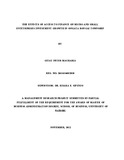| dc.description.abstract | The post independence period in Kenya was one of tremendous economic growth
characterized by conscious Government policy to transfer economic activity into the hands of
indigenous Kenyans and the banking sector was no exception I.
Twenty years after independence in 1983, several indigenous banks developed acute liquidity
problems. In spite of Treasury and Central Bank efforts to bailout the ailing institutions, one
institution was closed in December 1984. This bank failure exposed the inadequacy of safety-
net and failure resolution mechanisms existing at the time. This in effect, precipitated
amendments to the Banking Aet in 1985 to expand the safety-net and improve the bank
failure resolution mechanism.' However, in the ensuing period two more institutions
collapsed in August 1986 followed by a third one in January 1987 and these institutions were
placed under liquidation by the Official Receiver, a Government office under the Attorney
General's Chambers. | en |

